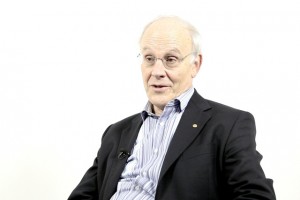Music and Autism
Psychologist Pamela Heaton on emotion recognition and musical abilities in individuals with autism
The video is a part of the project British Scientists produced in collaboration between Serious Science and the British Council.
Metamaterials allowed us to manipulate light in ways that we didn’t imagine even just about 15 years ago. This possibility has given rise to a number of applications for manipulating electromagnetic fields or what we understand as light. A particular way of bending, or manipulating, or morphing light is to bend it around an object. It’s a little like taking if you imagine light to be water flowing through a stream, and you put some, for example, a tree in the middle of the stream, then the water flows around that tree and the stream lines become parallel afterwards, so that an observer at the other side of that tree just sees the parallel lines. And what can happen there with water through the science of metamaterials we can now do with light. And we can take light and bend it around an object, so that an observer behind that object has no knowledge that the object is there becomes invisible.
What was noticed at that time was that Maxwell’s equations had a certain property that when you applied some transformation, some stretching or morphing of space, they retained the same structure. They’ve called it as invariance, or covariance, and it’s an idea that was very much emphasized by Einstein in his work on general relativity. But in terms of metamaterials and how it influenced the ideas that led to cloaking, it was a crucial idea that this bending of space left the equations in the same structure, in some sense. And not just in the same structure, but they told us an extra piece of information that hadn’t been noticed before. And that was that the mere transformation, which, of course, is something that occurs just in our minds, that’s just how we had written the equations down on a piece of paper, but actually told us something extra. They told us that by maintaining the same structure, this covariance of the equations, they actually told us how to make a material that would actually bend light. In our imagination we have two ways of describing something. The laws of physics have to look the same, however you transform something. Then that invariance told us that an extra piece of information that allowed us to actually build a material that could do that transformation, that squashing.
Now, it’s one thing I’ve been amazed about in my scientific career is how rapidly ideas are transformed into reality. Although this was a theoretical concept – the idea that you could make light to manipulate with metamaterials to make objects invisible was fascinating, but I suspected it will be some years before we would even happen the simplest demonstration. In fact, it was very shortly afterwards. I believe, in the same year of 2006 an experiment was performed in the microwave region — slightly longer wavelengths than visible light. That actually demonstrated an invisibility using a metamaterial about so big that was able to cloak an object about the size of a small coin. And we’ve demonstrated that it could be rendered invisible.
It wasn’t perfect, because there were technological limitations, but the crucial point, it seems to me, that this was a matter of technology rather than one of principle. Our principle is that we understand now how to make a cloak and we have to make objects invisible. It’s now a matter of technology to actually implement that. We can’t do it perfectly at the moment, but we’re getting better and better and indeed, we are now… Obviously, we would like to make invisibility cloaks at much shorter wavelengths, visible light, for example. And that imposes ever greater technological challenges, but we’re improving all the time. We reduce the problem to one of technology rather than one of principle.
In order to make objects invisible puts very severe challenges on the type of metamaterial that has to be created, it has to have an electrical and a magnetic response that are essentially identical. It’s very hard to manipulate the magnetic response, in fact, natural materials are magnetically unresponsive mostly, virtually all at high frequencies. Our challenge in terms of getting a perfect cloak is to achieve an identical electrical and magnetic response. Incidentally, the reason that we need an identical electrical and magnetic response is that’s precisely what happens to the light in vacuum. Light travels in vacuum in a particular way so that the electric and magnetic fields feel the same effects of vacuum. And we’re trying to reproduce that in our metamaterial, but in a stretched or morphed way. So one of the big challenges is to actually maintain the same response both electrical and magnetic.
Beyond the simple ideas of cloaking we would also like to be able to make structures that are much flatter. The idea of reducing some of the extreme parameters that are required to produce three-dimensional cloaking can be relaxed somewhat if we go to lower dimensions. So for example, in two dimensions it’s actually easier to produce a cloak. We’ve actually got a bit further in terms of cloaking big objects if we can go down to lower dimensions.

Until everyone’s researchers, funding agencies, and the children of researchers would all like to have an invisibility cloak that we can take to parties and things like that. That’s not going to happen in the immediate future. To give a perspective on the immediate direction of this field, my own view is that cloaking is an extremely interesting idea for hiding objects. But the likely technological significance is in terms of how it will influence the way we process and manipulate optical signals, in ways that perhaps are not immediately apparent to us, in some optical processing unit it will be possible to direct and manipulate light in ways that are not routinely done at present. So the output in terms of the impact that how it might affect our daily lives ultimately is in some sense hidden from us, if you will, a kind of conceptual cloaking. But as far as the end user is concerned, they’re not aware of little tricks that occur in the optical processing system. I believe that cloaking and other related technologies could form a significant part of the improvement in such devices.

Psychologist Pamela Heaton on emotion recognition and musical abilities in individuals with autism

Nobel Prize laureate David Gross on Rutherford experiments, asymptotic freedom, and the origin of the particle...

UCL team of scientists proposed novel way for significantly improving data transfer